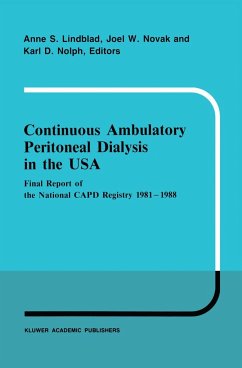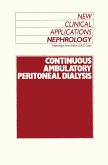A.S. Lindblad / J.W. Novak / K.D. Nolph (eds.)Final Report of the National Capd Registry 1981-1988
Continuous Ambulatory Peritoneal Dialysis in the USA
Final Report of the National Capd Registry 1981-1988
Herausgegeben:Lindblad, A. S.; Novak, J. W.; Nolph, K. D.
A.S. Lindblad / J.W. Novak / K.D. Nolph (eds.)Final Report of the National Capd Registry 1981-1988
Continuous Ambulatory Peritoneal Dialysis in the USA
Final Report of the National Capd Registry 1981-1988
Herausgegeben:Lindblad, A. S.; Novak, J. W.; Nolph, K. D.
- Gebundenes Buch
- Merkliste
- Auf die Merkliste
- Bewerten Bewerten
- Teilen
- Produkt teilen
- Produkterinnerung
- Produkterinnerung
The Final Report of the USA CAPO Registry summarizes eight years of observation and analysis that reflects the experiences of 485 clinical centers and over 25,000 CAPO patients. As such, it offers a wealth of information, available here for the first time to interested parties around the world. Because the National Institutes of Health was quick to see the potential of CAPO as a promising therapy for patients with end stage renal disease, the Registry project was begun soon after its introduction into clinical practice in the USA. Accordingly, the Registry offered the nephrology community in…mehr
Andere Kunden interessierten sich auch für
![Tobacco and Health Tobacco and Health]() K. Slama (Hrsg.)Tobacco and Health370,99 €
K. Slama (Hrsg.)Tobacco and Health370,99 €![Continuous Ambulatory Peritoneal Dialysis Continuous Ambulatory Peritoneal Dialysis]() Continuous Ambulatory Peritoneal Dialysis42,99 €
Continuous Ambulatory Peritoneal Dialysis42,99 €![Chronic Ambulatory Peritoneal Dialysis (Capd) and Chronic Cycling Peritoneal Dialysis (Ccpd) in Children Chronic Ambulatory Peritoneal Dialysis (Capd) and Chronic Cycling Peritoneal Dialysis (Ccpd) in Children]() Richard N. Fine (ed.)Chronic Ambulatory Peritoneal Dialysis (Capd) and Chronic Cycling Peritoneal Dialysis (Ccpd) in Children196,99 €
Richard N. Fine (ed.)Chronic Ambulatory Peritoneal Dialysis (Capd) and Chronic Cycling Peritoneal Dialysis (Ccpd) in Children196,99 €![Tobacco Tobacco]() Mark S. GoldTobacco65,99 €
Mark S. GoldTobacco65,99 €![Technical Advances in AIDS Research in the Human Nervous System Technical Advances in AIDS Research in the Human Nervous System]() Engene O MajorTechnical Advances in AIDS Research in the Human Nervous System65,99 €
Engene O MajorTechnical Advances in AIDS Research in the Human Nervous System65,99 €![Community-Acquired Pneumonia Community-Acquired Pneumonia]() Thomas J. Marrie (Hrsg.)Community-Acquired Pneumonia248,99 €
Thomas J. Marrie (Hrsg.)Community-Acquired Pneumonia248,99 €![Acquired Immunodeficiency Syndrome Acquired Immunodeficiency Syndrome]() Pascal James Imperato (ed.)Acquired Immunodeficiency Syndrome112,99 €
Pascal James Imperato (ed.)Acquired Immunodeficiency Syndrome112,99 €-
-
-
The Final Report of the USA CAPO Registry summarizes eight years of observation and analysis that reflects the experiences of 485 clinical centers and over 25,000 CAPO patients. As such, it offers a wealth of information, available here for the first time to interested parties around the world. Because the National Institutes of Health was quick to see the potential of CAPO as a promising therapy for patients with end stage renal disease, the Registry project was begun soon after its introduction into clinical practice in the USA. Accordingly, the Registry offered the nephrology community in the United States a special opportunity to study this emerging new therapy in some detail, an opportunity not previously available for any other form of dialysis. As will be seen in this report, the result of this early and intensive research effort has been the development of a vast amount of clinically important information regarding the utilization, safety, and efficacy of this important dialytic therapy.
Hinweis: Dieser Artikel kann nur an eine deutsche Lieferadresse ausgeliefert werden.
Hinweis: Dieser Artikel kann nur an eine deutsche Lieferadresse ausgeliefert werden.
Produktdetails
- Produktdetails
- Developments in Nephrology 23
- Verlag: Springer / Springer Netherlands
- Artikelnr. des Verlages: 978-0-7923-0179-0
- 1989.
- Seitenzahl: 272
- Erscheinungstermin: 30. September 1989
- Englisch
- Gewicht: 720g
- ISBN-13: 9780792301790
- ISBN-10: 079230179X
- Artikelnr.: 24472954
- Herstellerkennzeichnung
- Libri GmbH
- Europaallee 1
- 36244 Bad Hersfeld
- gpsr@libri.de
- Developments in Nephrology 23
- Verlag: Springer / Springer Netherlands
- Artikelnr. des Verlages: 978-0-7923-0179-0
- 1989.
- Seitenzahl: 272
- Erscheinungstermin: 30. September 1989
- Englisch
- Gewicht: 720g
- ISBN-13: 9780792301790
- ISBN-10: 079230179X
- Artikelnr.: 24472954
- Herstellerkennzeichnung
- Libri GmbH
- Europaallee 1
- 36244 Bad Hersfeld
- gpsr@libri.de
Section 1 Introduction.- Section 2 Registry Patient Population.- Section 3 Patient Characteristics.- Section 4 Complications of Treatment.- Section 5 Termination of Continuous Peritoneal Dialysis.- Section 6 Special Reports-1988.- Section 7 Special Reports-1987.- Section 8 Special Reports-1986.- Section 9 Special Report-1985.- Section 10 Special Report-1984.- Appendices.- I. Executive Advisory Committee of the National CAPD Registry of the National Institutes of Health.- II. Participating Centers of the National CAPD Registry of the National Institutes of Health.- III. Bibliography of the National CAPD Registry of the National Institutes of Health.- Table of Exhibits.- Section 2 Registry Patient Population.- Exhibit 2-1 Number of Patients Registered by Class and Type of Dialysis.- 2-2 Number of Patients Registered by Class and Year of Registration.- 2-3 Number of Patients with Follow-up by Class and Type of Dialysis.- 2-4 Last Contact and Status According to Activity Classification of Center for Patients Last Reported to be on CAPD/CCPD.- 2-5 Currency of The National CAPD Registry Database by Class of Patient.- 2-6 Number of Patients Receiving CAPD at Year End.- 2-7 Census and Flow of The National CAPD Registry by Year.- Section 3 Patient Characteristics.- Exhibit 3-1 Percent of Patients with Selected Characteristics by Type of Therapy.- 3-2 CAPD-Age Distribution by Sex.- 3-3 CCPD-Age Distribution by Sex.- 3-4 CAPD-Age Distribution by Race.- 3-5 CCPD-Age Distribution by Race.- 3-6 CAPD-Distribution of Patients by Primary Renal Disease Type According to Year of Registration.- Section 4 Complications.- Exhibit 4-1 CAPD-Occurrence of Selected Complications by Class of Patients.- 4-2 CAPD-Cumulative Probability of Experiencing First Episode ofPeritonitis (Class 1 Patients Only).- 4-3 CAPD-Complication Rates by Year of Registration.- 4-4 CAPD-Cumulative Probabilities and 95% Confidence Intervals (C.I.) of Experiencing Selected Events for the First Time by Year Registered (Class 1 Patients Only).- 4-5 CAPD-Cumulative Probability of Experiencing First Exit Site/Tunnel Infection (Class 1 Patients Only).- 4-6 CAPD-Cumulative Probability of First Catheter.- Replacement (Class 1 Patients Only).- 4-7 CAPD-Cumulative Probability of First Complication (Class 1 Patients Only).- 4-8 CCPD-Occurrence of Selected Complications by.- Class of Patient.- 4-9 CCPD-Cumulative Probabilities and 95% Confidence Intervals (C.I.) of Experiencing Selected Events for the First Time by Number of Months on CCPD (Class 1 Patients Only).- Section 5 Termination of Continuous Peritoneal Dialysis.- Exhibit 5-1 CAPD-Cumulative Probability of Transfer (Class 1 Patients Only).- 5-2 CAPD-Cumulative Probability of Receiving a Kidney Transplant (Class 1 Patients Only).- 5-3 CAPD-Cumulative Probability of Death (Class 1 Patients Only).- 5-4 CAPD-Cumulative Probability of Discontinuing CAPD Therapy for any Reason (Class 1 Patients Only).- 5-5 CCPD-Cumulative Probability of Transfer (Class 1 Patients Only).- 5-6 CCPD-Cumulative Probability of Receiving a Kidney Transplant (Class 1 Patients Only).- 5-7 CAPD-Cumulative Probability of Death (Class 1 Patients Only).- 5-8 CCPD-Cumulative Probability of Discontinuing CCPD Therapy for Any Reason (Class 1 Patients Only).- 5-9 CAPD or CCPD-Cumulative Probability of Transplantation: Pediatrics vs. 'Standard' vs. 'Other'.- 5-10 CAPD or CCPD-Cumulative Probability of.- Death: Pediatrics vs. 'Standard' vs. 'Other'.- 5-11 CAPD or CCPD-Cumulative Probability of'Technique Failure': Pediatrics vs. 'Standard' vs. 'Other'.- 5-12 Follow-up of Transfers to Hemodialysis Summary.- 5-13 Primary Reason for Leaving CAPD in Patients who Transferred from CAPD to Hemodialysis and Subsequently Returned to CAPD.- 5-14 Follow-up of Kidney Transplant Summary.- 5-15 Death Summary.
Section 1 Introduction.- Section 2 Registry Patient Population.- Section 3 Patient Characteristics.- Section 4 Complications of Treatment.- Section 5 Termination of Continuous Peritoneal Dialysis.- Section 6 Special Reports-1988.- Section 7 Special Reports-1987.- Section 8 Special Reports-1986.- Section 9 Special Report-1985.- Section 10 Special Report-1984.- Appendices.- I. Executive Advisory Committee of the National CAPD Registry of the National Institutes of Health.- II. Participating Centers of the National CAPD Registry of the National Institutes of Health.- III. Bibliography of the National CAPD Registry of the National Institutes of Health.- Table of Exhibits.- Section 2 Registry Patient Population.- Exhibit 2-1 Number of Patients Registered by Class and Type of Dialysis.- 2-2 Number of Patients Registered by Class and Year of Registration.- 2-3 Number of Patients with Follow-up by Class and Type of Dialysis.- 2-4 Last Contact and Status According to Activity Classification of Center for Patients Last Reported to be on CAPD/CCPD.- 2-5 Currency of The National CAPD Registry Database by Class of Patient.- 2-6 Number of Patients Receiving CAPD at Year End.- 2-7 Census and Flow of The National CAPD Registry by Year.- Section 3 Patient Characteristics.- Exhibit 3-1 Percent of Patients with Selected Characteristics by Type of Therapy.- 3-2 CAPD-Age Distribution by Sex.- 3-3 CCPD-Age Distribution by Sex.- 3-4 CAPD-Age Distribution by Race.- 3-5 CCPD-Age Distribution by Race.- 3-6 CAPD-Distribution of Patients by Primary Renal Disease Type According to Year of Registration.- Section 4 Complications.- Exhibit 4-1 CAPD-Occurrence of Selected Complications by Class of Patients.- 4-2 CAPD-Cumulative Probability of Experiencing First Episode ofPeritonitis (Class 1 Patients Only).- 4-3 CAPD-Complication Rates by Year of Registration.- 4-4 CAPD-Cumulative Probabilities and 95% Confidence Intervals (C.I.) of Experiencing Selected Events for the First Time by Year Registered (Class 1 Patients Only).- 4-5 CAPD-Cumulative Probability of Experiencing First Exit Site/Tunnel Infection (Class 1 Patients Only).- 4-6 CAPD-Cumulative Probability of First Catheter.- Replacement (Class 1 Patients Only).- 4-7 CAPD-Cumulative Probability of First Complication (Class 1 Patients Only).- 4-8 CCPD-Occurrence of Selected Complications by.- Class of Patient.- 4-9 CCPD-Cumulative Probabilities and 95% Confidence Intervals (C.I.) of Experiencing Selected Events for the First Time by Number of Months on CCPD (Class 1 Patients Only).- Section 5 Termination of Continuous Peritoneal Dialysis.- Exhibit 5-1 CAPD-Cumulative Probability of Transfer (Class 1 Patients Only).- 5-2 CAPD-Cumulative Probability of Receiving a Kidney Transplant (Class 1 Patients Only).- 5-3 CAPD-Cumulative Probability of Death (Class 1 Patients Only).- 5-4 CAPD-Cumulative Probability of Discontinuing CAPD Therapy for any Reason (Class 1 Patients Only).- 5-5 CCPD-Cumulative Probability of Transfer (Class 1 Patients Only).- 5-6 CCPD-Cumulative Probability of Receiving a Kidney Transplant (Class 1 Patients Only).- 5-7 CAPD-Cumulative Probability of Death (Class 1 Patients Only).- 5-8 CCPD-Cumulative Probability of Discontinuing CCPD Therapy for Any Reason (Class 1 Patients Only).- 5-9 CAPD or CCPD-Cumulative Probability of Transplantation: Pediatrics vs. 'Standard' vs. 'Other'.- 5-10 CAPD or CCPD-Cumulative Probability of.- Death: Pediatrics vs. 'Standard' vs. 'Other'.- 5-11 CAPD or CCPD-Cumulative Probability of'Technique Failure': Pediatrics vs. 'Standard' vs. 'Other'.- 5-12 Follow-up of Transfers to Hemodialysis Summary.- 5-13 Primary Reason for Leaving CAPD in Patients who Transferred from CAPD to Hemodialysis and Subsequently Returned to CAPD.- 5-14 Follow-up of Kidney Transplant Summary.- 5-15 Death Summary.








